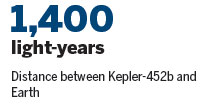Planet 'can unlock Earth's secrets'
Updated: 2015-07-25 08:08
By Zhao Lei(China Daily)
|
|||||||||||
The discovery of a planet described as a "close cousin" of Earth will help mankind to learn more about the genesis of our world and the creation of life on it, a Chinese astronomer said.
Zheng Yongchun, an expert at the National Astronomical Observatories under the Chinese Academy of Sciences, said scientists have only a limited knowledge of Earth's past and are unable to forecast what will happen to it in the future.
Comparative research into Earthlike planets will enable them to develop a better understanding of these matters, Zheng said.
On Thursday, experts at the US' National Aeronautics and Space Administration announced that they have identified an Earthlike planet orbiting a sunlike star and said it might harbor life.
"It is the closest thing that we have to another place that somebody else might call home," Jon Jenkins of NASA's Ames Research Center in California was quoted by The Associated Press as saying.
This older, bigger planet, called Kepler-452b, is remarkable in that it orbits its star at about the same distance that Earth orbits the sun. Additionally, the star it orbits appears to be similar to Earth's sun.
Jenkins, who led the team that discovered Kepler-452b, said it is the nearest thing to another Earth-sun twin system, according to AP.
"Today the Earth is a little less lonely because there's a new kid on the block," he said.
However, Zheng said it is impossible for mankind to reach planets outside the solar system using current space technology.
"Even at the speed of the fastest existing spacecraft, the United States' New Horizons interplanetary probe, which flies at about 59,000 kilometers per hour, it would take more than 27 million years to get to Kepler-452b," he added.

"Even if we reach an Earthlike planet someday in the future, we must make sure there is an atmosphere like Earth's, liquid water and suitable temperatures before landing. In addition, the surface should be rocky, and the release of energy by the planet's home star must be stable."
Kepler-452b, about 1,400 light-years from Earth in the constellation Cygnus and about 6 billion years old, is approximately 60 percent larger in diameter than Earth, It is classified as a super-Earth-size planet and is the smallest planet to date discovered orbiting in the habitable zone-the area around a star where liquid water can pool on the surface of a planet - of a G2-type star, like our sun.
Launched in 2009, the Kepler mission identifies potential planets by looking for periodic blips against the brightness of stars.
John Grunsfeld, NASA's science mission chief, said the project will continue to make new discoveries.
Millions of Chinese Internet users have been following NASA's latest breakthrough on social media. More than 59 million had read posts with the hashtag "another Earth" on Sina Weibo by late Friday, and nearly 120,000 had taken part in discussions about the issue.
zhaolei@chinadaily.com.cn
(China Daily 07/25/2015 page1)
Today's Top News
Discovery of Earth-like planet disappoints Chinese Web users
Financial Times sale – the deal no-one saw coming
Deficit hits $104b in first half
The meritocracy of the Chinese system
Turkish warplanes destroy IS targets
Warriors star in lakeside opera spectacular
Greek parliament passes crucial bailout bill
Astronomers discover most Earth-like planet yet
Hot Topics
Lunar probe , China growth forecasts, Emission rules get tougher, China seen through 'colored lens', International board,
Editor's Picks

|

|
|

|

|

|






